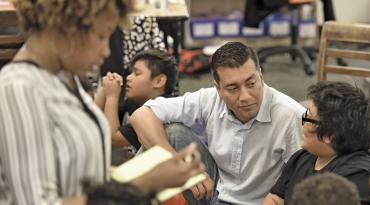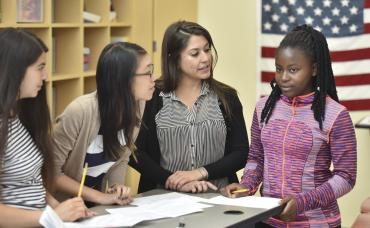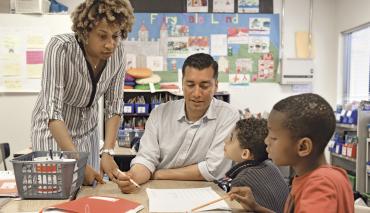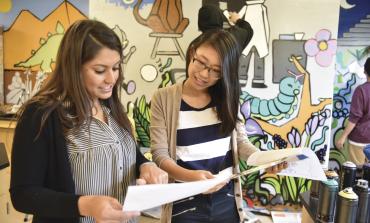One morning in March, the second-graders in Room 11 at El Dorado Elementary School in San Francisco sit on the reading carpet and squirm. To help them focus, Andy Castro asks them to close their eyes and take a few mindful breaths. Once they settle down, he begins a lesson on opinion writing. Today, he tells them, they will practice writing introductions. “Let’s hook our readers,” he says. “That means grab their attention.”
He points to a large sheet of paper next to him with a few helpful reminders. “Opinion writers hook in readers by asking a question. Have you ever…? Do you…?” After reviewing some examples, he asks students to brainstorm introductory sentences with their partners. Little voices excitedly call out “Do you like ninja games?” and “Do you like school?” When Castro asks a boy named Raydell to stand and read the first line of his piece about skateboarding and then compliments his work, the student beams.
The lesson on hooking readers is an apt metaphor for what Castro himself has been engaging in all year: getting hooked on teaching. It’s a fundamental goal of school districts across the country. And Castro is in a residency program that is grabbing their attention.
As a graduate student earning a master’s degree in education at the University of San Francisco, Castro is actually a student teacher. While student teaching is a crucial part of teacher preparation, in most programs it lasts only a few months. What makes Castro’s experience unique is that he has taught in the same classroom with the same teacher who has mentored him all school year. He has also received extensive coaching and considerable financial assistance to complete his degree and earn his teacher certification—far more than what many education programs offer. That’s because he also participates in a program that provides select student teachers with targeted supports: the San Francisco Teacher Residency (SFTR).
SFTR is a consortium that includes the San Francisco Unified School District, the United Educators of San Francisco, and two area colleges, the University of San Francisco School of Education and the Stanford Teacher Education Program. SFTR pairs graduate students (“residents”) from both universities with mentors (called “cooperating teachers”) who are classroom teachers in San Francisco. And it provides residents and cooperating teachers with coaches who observe lessons and support each pair in working together. After completing the program, SFTR graduates are guaranteed teaching positions in San Francisco public schools. Just as important, the program continues to provide each new teacher with coaching during his or her first two years on the job.
Inspired by teacher residencies in Boston and Chicago and built on the medical residency model, SFTR began in 2010. Like those two programs, it was established to recruit, prepare, and retain teachers, particularly for hard-to-staff, high-poverty schools. There are about 50 such residencies nationwide.
Since SFTR’s inception, this competitive program has graduated nearly 175 educators, 80 percent of whom still teach in the city. District officials say the program’s stellar retention rate, along with other teacher pipeline initiatives, can help mitigate the effects of the local teacher shortage, which shows few signs of abating. Two summers ago, the district had to fill 656 vacant teaching positions—vacancies that resulted from a mix of retirements and resignations. This past summer, that figure slightly increased to 664. In recent years, district officials say they have hired upward of 200 teachers on emergency credentials, compared with only a handful a decade ago.
San Francisco is hardly alone in trying to attract educators. In fact, the entire state of California faces an alarming teacher shortage.1 But the high cost of living in the Bay Area, the tech capital of the world, has made it especially difficult for teachers to afford to live there. In the last few years, housing costs in the city have skyrocketed; the average home now sells for more than a million dollars.2 That’s a steep price tag for beginning teachers in San Francisco, who earn about $57,000 a year. To save money, many young teachers live with roommates just as they did in college, or they endure long commutes. As soon as they decide to start families, however, they find teaching positions and cheaper housing elsewhere. By providing residents with a partial tuition reimbursement, a living stipend, and a housing allowance, SFTR hopes to reverse this trend.
SFTR organizers also seek to diversify the city’s educator workforce to reflect the racial and ethnic makeup of students. Of the district’s 3,744 teachers in 2016–2017, approximately half were white, while only 14 percent of the district’s 55,613 students were white. In the last three years, two-thirds of the residents SFTR has enrolled identify as people of color.
Recently, research has highlighted the promise of teacher residencies: they retain teachers for more than the three to five years that new teachers tend to stay in the classroom, they recruit a greater proportion of teachers of color, and the handful of programs that have been studied have shown a positive impact on student achievement.*
At a time when our schools face a national teacher shortage, including the challenge of recruiting and retaining teachers of color, the teacher residency offers a way for a school district, a teachers union, and local universities to join together in nurturing the next generation of classroom talent. It’s also a way to bolster teacher preparation programs, which have long been criticized for a lack of rigor and for focusing too much on educational theory and too little on classroom practice. “Teacher education is under attack constantly,” says Ruth Ann Costanzo, director of clinical work at the Stanford Teacher Education Program (STEP) and the university’s liaison to SFTR. “We have a really good model, and our graduates are proof of that.”
Supporting Clinical Work
The history of SFTR starts with Linda Darling-Hammond, professor emeritus of education at Stanford, the former faculty sponsor of STEP, and now the CEO of the Learning Policy Institute. According to Costanzo, who has been with SFTR since it began in 2010, Darling-Hammond guided STEP in establishing a residency to give prospective teachers more intensive clinical preparation. STEP then sought out partners, including the San Francisco Unified School District, the United Educators of San Francisco, and the University of San Francisco.
Together, they created a curriculum and a structure to support a select group of graduate students. In that first year, the program accepted 15 residents. Last year, the number grew to 43. This year, organizers capped it at 35 to maintain program quality. As a sign of growing demand, nearly 150 people applied this year, compared with 130 last year.
To qualify, candidates apply concurrently to SFTR and to the master’s program at either the University of San Francisco or Stanford. They submit an essay about why they want to teach in a high-need San Francisco school, and they sit for an hourlong interview with representatives from all SFTR’s partner organizations.
Each of the university’s graduate programs lasts one year, as does the one year of student teaching that SFTR requires. Besides their university coursework, every Friday residents attend a three-hour seminar, referred to as a practicum, led by SFTR staff members, in which residents discuss their student teaching experiences and hear from speakers such as school district leaders, teachers, parents, and others connected to schools in San Francisco.
Tuition for graduate programs in education at the University of San Francisco and Stanford total about $33,000 and $48,000, respectively. To offset these costs, residents have received a living stipend of about $13,500 and an education award of about $6,000. (This school year, the living stipend, which was provided by AmeriCorps, is no longer available.) After earning their master’s degree and teaching credential, and upon becoming teachers in the San Francisco school district, residents also become eligible for a $4,800 housing stipend each year for three years, provided by the Teachers Housing Cooperative, a nonprofit that has provided grants since 2000 to San Francisco Unified School District teachers renting in San Francisco.
SFTR relies on grants and school district funding to support four full-time and two part-time coaches who work with residents and cooperating teachers. As compensation for mentoring residents, cooperating teachers, who teach various grade levels throughout the district, receive a $2,500 stipend, funded by a local parcel tax.
“Years ago, we were strict about looking for cooperating teachers who had at least five years of teaching experience,” says Jonathan Osler, SFTR’s former executive director. But over time that requirement has shifted, given the district’s teacher turnover rate. Also, SFTR officials have found that placing residents with cooperating teachers who are recent SFTR graduates enables cooperating teachers to continue receiving instructional guidance.
The model is “closer to what we would like to see in teacher preparation, which is a lot of support for their practical work,” says Rick Ayers, associate professor of teacher education at the University of San Francisco. A yearlong residency, he adds, contrasts with “these quickie credential programs like Teach for America” in which candidates attend a few weeks of summer training for what are often isolating classroom experiences. “Those, I think, do not prepare people well.”
Ayers is not alone in this view, which research supports. A study found that only 20 percent of teachers from Teach for America placed in the San Francisco district were still teaching there five years later.3 Last year, amid growing concerns, the district did not renew its contract with the organization.4
Lita Blanc, the president of the United Educators of San Francisco, notes that an important aspect of the residency is that it offers a continuum of professional growth. “The SFTR model takes into account that the cooperating teacher also has a stake in perfecting her craft.”
Blanc also lauds it as a genuine example of labor-management collaboration.† The union is an equal partner in SFTR, with union officials sitting on the program’s advisory board, which meets quarterly. In the past, the union has helped raise funds for the program, such as a three-year grant for $178,000 each year from the National Education Association (NEA). Since the grant ends this year, the United Educators of San Francisco hopes to pursue further NEA funding.
Coming together on a project like SFTR has enabled the union and the district to work together, Blanc says, and that has had a ripple effect. “It serves us well when we’re trying to problem solve in other areas.”
Chris Canelake, the executive director of the school district’s office of professional learning and leadership, which oversees SFTR, agrees. The school district and the union have a common interest in raising the bar on teacher preparation, he says. That shared purpose has made the residency “the gold standard of teacher preparation,” he explains, adding that his district receives queries from other school districts across the country looking to replicate the model. The district also participates in the National Center for Teacher Residencies, a network that enables programs to learn from each other.
Canelake says that once residents graduate from SFTR, they are highly sought after. The district’s principals have come to understand that to find “the very best-prepared teachers, the residency is really one of the first places to look.”
Strengthening the Teacher Pipeline
El Dorado Elementary School, where Andy Castro did his student teaching, is in San Francisco’s Visitacion Valley, about six miles from downtown. The neighborhood is one of the city’s poorest, with 72 percent of its 236 students eligible to receive free or reduced-price meals. More than a third are English language learners, most of whom speak Spanish at home.
The school has partnered with SFTR since the program’s inception; for years El Dorado has been a hard-to-staff school. Of its 12 classroom teachers, about four leave every year, says Silvia Cordero, El Dorado’s principal. In her five years as principal, Cordero has come to value SFTR. Through the program, “I’ve been able to hire some good teachers,” she says. One of her most recent hires is Castro, now officially teaching second grade. That makes six teachers at El Dorado—in kindergarten, first, second, third, and fifth grades—alumni of the program.
Castro says that during his residency, he learned a great deal from his cooperating teacher, Nikki Thornton Street. In her second-grade classroom, he learned how to plan lessons, engage students in their learning, use concise language, and implement effective classroom management techniques. Throughout the school year, Thornton Street offered increasingly tapered support, with Castro gradually taking the lead on instruction. In March, he felt confident enough to teach what SFTR calls a “solo week.” The week entails a resident teaching the entire school day, while the cooperating teacher observes and offers suggestions.
Castro and Thornton Street both agree the week went smoothly; he effectively covered the material. But a few times, students lost their focus, and Castro had trouble getting them back on track. When it comes to discipline, “Nikki does that very well,” he says. “She’s like this warm demander.” By that he means students know their teacher cares about them and also expects them to pay attention.
Thornton Street has been a cooperating teacher since SFTR began, which makes Castro her seventh resident. She’s impressed with how reflective and open he is to suggestions, and she praises his ability to build strong relationships with students. A visit to the classroom in March was proof of that, with students clamoring to work with him.
Serving as a mentor, she says, has made her a better teacher. “Having someone in here watching me, I feel like I have to be more intentional in my moves.” And having to explain them has pushed her to improve. Working with Tim Nunes, Castro’s instructional coach from SFTR, has also helped Thornton Street hone her craft. When Nunes would observe Castro teach for 45 minutes to an hour every other week, he would also suggest ways Thornton Street could better support Castro.
Thornton Street knew from an early age she wanted to be a teacher; as a child she often played school at home. Castro, however, decided to pursue teaching after graduating from the University of California, Los Angeles. For a time, he worked in an afterschool program, where he enjoyed helping elementary school students develop social and emotional skills.
But he graduated with a significant amount of debt. Concerned about adding to it, he chose to apply to the University of San Francisco and SFTR after a director at the afterschool program sent around an informational e-mail. The intensive preparation and financial assistance appealed to him, and he applied.
To save money, Castro lives in Oakland, where housing tends to be slightly cheaper. He rents a studio apartment and takes public transportation to El Dorado. His nearly hour-and-a-half commute and his long workday illustrate his commitment to his career. He wakes up each day at 5 a.m. to arrive at El Dorado by 7 a.m. Just like the official classroom teachers, he stays the full school day as well as after school for meetings, except Fridays when he leaves before 1 p.m. to attend an SFTR seminar. In the evenings, he takes classes at the University of San Francisco before heading home.
Originally from Los Angeles, Castro says that his parents, immigrants from El Salvador, support his chosen profession but did not have the resources to guide him through higher education. He and his older brother, a college counselor in New York City, are the first in their family to graduate from college.
Castro says being the son of immigrants has helped him connect with El Dorado students whose parents also came to this country seeking a better life. Other SFTR residents with similar backgrounds say the same thing.
Learning from Student Teaching
A mile away from El Dorado is Visitacion Valley Middle School, where Bianca Shiu completed her residency. Like Castro, Shiu, who grew up in Arlington, Texas, is the child of immigrants. Because her parents came to this country from Hong Kong and Taiwan, she is keenly aware of the language and cultural barriers many families face.
Roughly 50 percent of the school’s 473 students are English language learners, and most speak Spanish at home. Although hardly fluent, Shiu speaks some Spanish and always makes an effort to do so when talking to families. “That can really show parents that our school is trying to reach out to them,” she says.
Visitacion Valley faces challenges similar to El Dorado’s. “We’re literally and sometimes figuratively on the margins of the city,” says Joe Truss, the principal. He explains that the school is far from “the glitz and glamour of San Francisco” but very close to Sunnydale, the city’s largest public housing project, where many students live. As a sign of families’ economic struggles, more than 80 percent of students receive free or reduced-price meals.
Truss says many parents work two jobs. Recently, he spoke with a principal from a more affluent part of the city whose PTA raised $300,000. “We raise zero dollars,” Truss says. So he spends part of his time writing grant applications and soliciting funds to help support his school.
Now in his third year as principal, Truss has been impressed with SFTR residents, whom he considers hard-working and highly skilled. “They tend to come with a really good mindset and a philosophy toward equity in education.”
He says that Shiu and her cooperating teacher, Brittany Villalobos-Gillett, an eighth-grade science teacher, enjoy a strong partnership. In fact, they work so well together and are so close in age that when a visitor watches them teach in March, it’s difficult to tell the resident from the cooperating teacher.
When we spoke, Shiu, who is 25, was earning her master’s degree in education from Stanford. After graduating from Pomona College with a degree in neuroscience, she worked with AmeriCorps for two years teaching students in an afterschool program in Oakland. She had volunteered in afterschool programs while at Pomona and enjoyed the work so much that she decided to pursue a career in education. When she searched online for information about teacher education programs, she came across SFTR. The financial help and professional support convinced her to apply.
Spending an entire year with an experienced teacher has prepared her to plan and facilitate lessons and manage a classroom. This year, she’s putting her knowledge and skills to use teaching eighth-grade science in Oakland. “I just didn’t want to be thrown in there immediately and not serve my kids very well,” she says.
Working with Villalobos-Gillett, who is 28 and an alumna of SFTR, was a good fit. Shiu appreciates how intentional the program is in pairing residents with cooperating teachers. To that end, residents fill out a survey about their personalities, values, and working styles so SFTR officials can make the best match.
While Shiu has already taken a wide variety of education courses—in curriculum and instruction in science, equity in schooling, supporting students with special needs, language policies and practices, and assessment, among other topics—she values the weekly seminar where residents from both Stanford and the University of San Francisco discuss their common experiences teaching in the San Francisco Unified School District.
Amy Millikan, the director of clinical education for SFTR, says that unlike a typical teacher preparation course, the seminar does not give students typical graduate assignments outside of class. Rather, residents “use their classroom experience as the text for processing what’s happening,” she says. In other words, residents spend that time mostly reflecting on and analyzing their teaching experiences. And they also discuss broader questions, such as what it means to teach in an underresourced school in San Francisco. After all, “this is a context-specific program in which we’re working to help our residents first understand how to teach well and then understand how to teach historically marginalized students in San Francisco well,” she says.
As California faces its worst teacher shortage in decades, SFTR offers a powerful model of teacher preparation worth expanding. It requires a significant investment in terms of both funding and logistical support from a school district, a teachers union, and local universities—organizations that may not have a strong history of working together.
But if such a partnership exists, as it does in San Francisco, then a residency program can rigorously prepare teachers for hard-to-staff schools. And by pairing residents with mentors, these programs can help strengthen instruction beyond the ranks of novice educators. In any profession, the best mentors admit they still have more to learn.
Now in her fifth year of teaching, Villalobos-Gillett recalls the intensive support she herself needed as a resident. Observing her teaching, it’s hard to believe she once had trouble commanding a classroom. The University of California, Berkeley graduate with a degree in public health says she relied on plenty of guidance in structuring lessons, engaging students, and even speaking in front of a class.
Just as important, she undertook all this work without paying the full cost of tuition. Thanks to SFTR, she now owes $20,000 for her master’s degree from the University of San Francisco. Part of her salary of about $61,000 a year goes toward paying that off, as well as paying off the $35,000 of debt she accrued in earning her undergraduate degree.
Among the many benefits of SFTR is the chance it has given her to advocate for the profession. In February, the organization asked her to testify at a joint hearing of the California Senate and Assembly education committees as they examined the causes of and potential solutions to the state’s teacher shortage. In her remarks, Villalobos-Gillett explained how “SFTR attracts quality teachers by elevating the profession to the level of respect it deserves.”
She also extolled the program’s comprehensive approach to teacher preparation. By the time she graduated, she had analyzed school accountability report cards and districtwide health and wellness surveys, met with the local teachers union president and San Francisco parents, and been trained in restorative justice practices. She also spoke of the bus trips she had taken “to the parts of the city my students call home.”
Today, Villalobos-Gillett’s home is about a 10-minute drive to Visitacion Valley Middle School. She pays $1,250 a month to share an in-law unit with a roommate in the basement of a house. “It’s not necessarily in one of the more up-and-coming areas,” she says. But it’s what she can afford.
Like Castro and Shiu, Villalobos-Gillett did not graduate from college intent on becoming a public school teacher. The residency program solidified her decision because it offered rigorous training. It also provided financial support for a career that has increasingly become out of reach for those who want to teach but lack the funds to do so. As a result, Villalobos-Gillett plans to spend her career sharing her passion for science in a high-poverty school.
“I’m eternally grateful for the training I got,” she says. It goes without saying that her colleagues and her students are too.
Jennifer Dubin is the managing editor of American Educator. Previously, she was a journalist with the Chronicle of Higher Education. To read more of her work, visit American Educator’s author index.
*For more on the teacher residency model, see “The Teacher Residency” in the Spring 2017 issue of American Educator. (back to the article)
†For more on the benefits of labor-management collaboration, see the Winter 2013–2014 issue of American Educator. (back to the article)
Endnotes
1. Anne Podolsky and Leib Sutcher, California Teacher Shortages: A Persistent Problem (Palo Alto, CA: Learning Policy Institute, 2016).
2. “San Francisco Home Prices & Values,” Zillow, accessed June 15, 2017, www.zillow.com/san-francisco-ca/home-values.
3. Podolsky and Sutcher, California Teacher Shortages.
4. Jill Tucker, “SF School Leaders Give Teach for America a Time-Out,” San Francisco Chronicle, May 12, 2016.




